This time, we’re journeying to the Ruby Red Planet, Mars. Elon Musk thinks he’ll have people there by 2024; NASA will be following closely behind with a touchdown expected in the 2030s. That means that in our lifetime, we will become an interplanetary species. But what will it be like for those brave individuals? Graihagh Jackson investigates...
In this episode
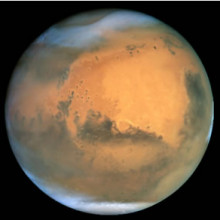
01:06 - The roadmap to Mars
The roadmap to Mars
Stephen Petranek, author of How We'll Live on Mars
6 years seems like an incredibly ambitious timeline to get people on Mars, especially given Elon Musk’s Falcon rocket explosions and European Space Agency’s crash landings onto the Martian surface. If we can’t get cargo off the ground, how will we get humans out there? Graihagh Jackson put this to Stephen Petranek...
Stephen - I’m Stephen Petranek, I wrote the book “How We’ll Live on Mars.”
Graihagh - How will we live on Mars?
Stephen - Very successfully and much sooner than anyone expects. Elon Musk says he’ll land people on Mars in 2024. I’m giving him about a two-year break, so maybe 2026/2027. He’s the most optimistic person on the face of Earth. I honestly think that that there’s a better than 90 percent chance there’ll be people on Mars by 2030.But the real kicker is how many people will be on Mars by 2050? Because by 2050, if Elon Musk is correct, he'll have 1,000 rockets leaving at one time, each with 80 people in them. That's 80,000 people going to Mars in one trip, so it's highly conceivable that by 2040 there are 10,000 people on Mars, and very conceivable by 2050, there’s 100,000 on Mars, and you're going to need 1 million people to actually create another civilisation and a real backup for humans.
Graihagh - Well we’ll come to that in a minute. But I just want to unpick this 2027 because I mean, we've had problem after problem. I'm thinking with the Falcon rockets, the last one exploded back in September, right? And then we've just had the ESA Mars rover crash land on to Mars, not to mention Beagle…
Stephen - Don't get me started on ESA and Beagle.
Graihagh - If we can't get rovers to Mars and if this is only ten years away, how are we going to get people?
Stephen - This is a matter of money, and it's a matter of playing the odds in the space game. Rockets are binary - they work or they don't work. About 20 percent of the time they don't work. We had two shuttles that went down with eight people in each one of them. This is a dangerous business. It's not like getting in an aeroplane. There was a time when getting in an aeroplane was almost as risky as going to Mars. And going to Mars is going to be very risky for a long time, but that is not going to stop anyone from going.
Graihagh - Well, why wouldn't it though? Why would we even want to go?
Stephen - Well we really need a backup for civilisation on Earth. I mean we are long overdue for being hit by a major asteroid, larger than the one that took out the dinosaurs 65 million years ago. There’s 100 percent probability and that's just one of many, many, many extinction events for humans on Earth. And we also know that Earth is going to look a lot like Mars in about 100 million years. There isn’t going to be an atmosphere here, it’s going to be a cold place, all the water on the surface will be frozen. We've spent 95 percent of our existence as humans moving beyond the horizon into the next wilderness because it's a matter of survival. And we have to learn to be a spacefaring species and move onto other planets and then move on to other solar systems.
I mean frankly, think of everything we’ve accomplished in art and culture and learning and to have all of that just literally get exploded and go up in smoke one day from an asteroid - it’s crazy.
Graihagh - ‘I'm sort of imagining something like Noah’s Ark. Surely all these beautiful, amazing things that nature has made should be coming along with us too - right? Otherwise, that’s a human, centric view of things.
Stephen - Yeah, that’s a very good question as to what kind of life forms you want to take with you. I don’t think we’re really going to have a lot of choice about that over the long haul because first of all there’s about 100 million different living creatures in our gut - right? And they’re coming with you.
Graihagh - What about my cat?
Stephen - Your cat may not come with you. It may be a very expensive trip for your cat - it’ll cost you 100,000 dollars to take your cat. If we find that we can create a good environment for living on mars relatively easily and that Mars can become its own economic system and be self-supporting and self-sustaining, it will be very interesting what kinds of animals we choose to put on that ark and bring with us.
Graihagh - I’m wondering if people will bring their Tamagotchis as a surrogate instead. Do you remember Tamagotchis?
Stephen - No.
Graihagh - They’re like these little toys that I had when I must have been about ten.
Stephen - Oh yeah, yeah, yeah. You had to press their buttons every so often to keep them alive, yeah, yeah.
Graihagh - And you had to pick up their poo otherwise they died and all sorts of thing like that. Teaching responsibility to children.
Stephen - Those little Japanese things… you notice they didn’t last.
Graihagh - Okay. So let’s turn to say we managed to overcome so many problems and we do end up on Mars, as you say, in 2027.
Stephen - Listen. The whole point of this, the whole point of my book is to go - hello people, we are going. This is not a fantasy, this is not something people are making up. I mean, we’re going, there’s no if, ands, or buts. It’s happening.
Graihagh - It just sounds very abstract to me… still.
Stephen - Well, wake up! If you think this isn’t happening you’re dreaming. This is happening!
Graihagh - Okay then.

07:01 - What's it like to live in microgravity?
What's it like to live in microgravity?
Stanely G Love, NASA Astronaut
Living without gravity can have some serious side effects, as astronaut Stanley G Love explained to Graihagh Jackson...
Stanley - You get strapped in 2.5 to 3 hours before you launch. You'll get plenty of time to think about whether that was really a good idea.
Graihagh - What was going through your mind?
Stanley - Well, there are two sort-of astronaut's prayers where the standard one is 'I really hope I don't screw up' and not everybody admits but many people are also hoping they don't get blown up.
Launching from the ground to reaching orbit takes about 8 minutes. During that time, there are milestones that you're sort of checking off - places where you say, "Okay, from this point on, if we lose an engine, we're going to fly across the Atlantic and land in Africa whereas before that, if we lost an engine, we would've tried to turn around and land back in Florida." There's also a milestone that my commander read off to us over the headsets. He made a little congratulatory statement for us rookies on-board, congratulating us on making it to space and officially becoming astronauts. When the engines cut-off and you're floating in orbit, that's 40 per cent of the risk of your entire space mission has just been retired in those 8 minutes. So, you get a good feeling thinking, "This just got about twice as safe as it used to be when I was sitting on a pad 8 minutes ago." So, that's a great feeling. Floating in your straps is just amazing and then the next thought to hit you is, it is now time to get to work.
Graihagh - Paint me a picture of life in space. I imagine microgravity plays havoc on all sorts of things in terms of how you sleep but also how you eat and shower, and all that sort of thing.
Stanley - Yes, shower. Who said anything about showers?
Graihagh - Two weeks without a shower?
Stanley - Imagine turning off the gravity and turning on the shower. Water would go flying everywhere. So, if you want to take a bath, it's going to be a sponge bath.
But you're right, daily life really has a lot of changes when you're in microgravity especially at first when it's disorienting. I mean, there's a few fine aspects especially after a couple of days, you'll get used to it. So, you can actually put your pants on both legs at the same time in microgravity, but getting into bed, setting up a bed takes a long time. You're setting up a sleeping bag basically that's attached to the wall or the floor, or the ceiling if you like.
Changing clothes is hard, eating is hard. Most of our foods are in sort of packets and you kind of cut open a corner and kind of nibble or if it's a liquid stuff, you kind of suck the contents out. It just takes a long time to get anything done. Going to the bathroom can take half an hour especially the first couple of times. The biggest surprise on the whole flight for me was not during the flight but after landing. As your system gets used to being in gravity again, you can be very dizzy like your head is spinning. I didn't quite expect that. I expected some of the other effects to feel kind of weak, maybe sick to my stomach. I did not expect to be dizzy. But in general, we were very, very well prepared for our flight and folks who had been there came back and told us about their experiences so there were not very many surprises.
Graihagh - You're mentioning the effects of microgravity there and there's lots of talk about the effects on bone density and muscle wastage, was this something you encountered after 2 weeks after you returned back to Earth?
Stanley - Absolutely, but I was a bad astronaut and I did not do my exercise. But I had ample time to regret that when I came home. So, I lost 8 pounds of muscle, almost all out of my legs. If I went again, I would not blow off my exercise because it made a huge difference. And that was only 2 weeks. You can imagine if you were up there for 12 times longer than that, being up there for 6 months.
Graihagh - How long did it take you to recover those 8 pounds of muscle?
Stanley - Several months.
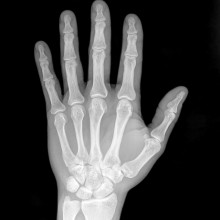
11:34 - Why microgravity could halt human exploration of Mars
Why microgravity could halt human exploration of Mars
Mark Wilson, Imperial College London
Microgravity has serious impacts on the body, including loss of bone, muscle and vision. Mark Wilson and Graihagh Jackson discuss why this is such a problem when journeying to Mars...
Mark - Well, there's different studies, but on average, the studies seem to show that people lose between one per cent and five per cent of their bone mineral density, per month that is, during microgravity. That's quite a lot if you're going to be spending nine months travelling somewhere. We don't know whether it plateaus off and some of the evidence from the International Space Station suggests that it does. But if it's not going to plateau off, then you're obviously going to have quite a lot of loss before you arrive.
Graihagh - The problem is that Mars does have gravity - not as much as Earth - but enough and that means you can’t lose too much otherwise you won’t be able to walk around on the surface. There’s a horrible phrase I’ve heard used to describe the problems of microgravity: you won’t trip and break a bone; you’ll break a bone and trip.
I.e. your bones are so thin and weak, gravity can snap them.
Mark - Well, because they aren't exercising in a normal way, and by that, I mean, when you normally exercise, you're walking or you're running, you have constant impact exercise, that's what helps bone turnover effectively. Because they haven't got that they lose bone mineral density and the other thing they haven't got is gravity pulling blood into the tissues. So even when people have exercised in space, for example, just running on a treadmill with braces to hold them on it, they still lose bone mineral density and muscle mass because although they've got impact exercise, they haven't got the gravitational force pulling blood into their legs. So, those are the two things; it's blood flow and impact exercise that are required to maintain bone mineral density and muscle mass.
We don't really know enough at the moment in terms of whether we can optimise things with hormonal treatments or with additional calcium and vitamin D and things like that. It does seem to be that really, to maintain bone mineral density and muscle mass, you have to be using them. And so, as drugs might offer a small benefit, it is unlikely to be the sole solution.
Graihagh - But bone density it’s Mark’s main concern...
Mark - My area of research is what happens to the brain in microgravity and hypoxia. What happens is is that because you haven't got gravity pulling blood into your legs, you get this fluid shift and we think that the intracranial pressure rises. What's happening is that you've got this reduced ability to drain venous blood. If you're sitting here now, you're putting about a litre of blood into your head every minute and that litre of blood has to get to get out every minute as well. When you have not got gravity helping that you can't drain blood quick enough.
What's happening, we're finding in longer space missions now, the chronic changes that are occurring are actually causing another phenomenon which is known as VIIP or Visual Impairment and Intracranial Pressure in space where the astronauts are losing peripheral vision and this is also a long-term problem that could be an issue in a mission such as one to Mars.
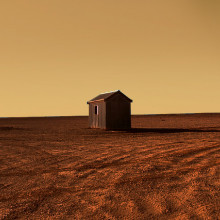
14:39 - The Martian environment
The Martian environment
Stephen Patranek, author of How We'll Live On Mars
Mars is hostile, there's no getting around that so how will humans survive? Stephen Patranek believes he has the answer, as he explained to Graihagh Jackson...
Stephen - On Earth, you need food, shelter, clothing and water to survive. On Mars you need, food, shelter, clothing and water and oxygen. So the only thing that’s really missing on Mars, basically, is oxygen. You have some other problems like you have significant radiation on Mars so you have to shield yourself from it. You have to shield yourself from solar radiation - you’ll get a terrible sunburn in about five minutes on Mars. You have to shield yourself from solar radiation. That’s a simple problem of just having walls that are thick enough. Or staying out of the sun, building your environment underground, building your environment in a lava cave, building your environment on the side of crater wall where the sun doesn’t shine on you.
You have another significant problem which is cosmic rays. These are very highly charged particles and by that we mean they’re moving with a lot of energy at a high rate of speed. So you’ve got protons, neutrons and electrons, basically stripped out atoms, and we don’t even know where these things come from for sure. But we know that they’re consistent in the universe and then everywhere you go we’ve got them. And they’re a big problem because when the pass through your body they’re causing a lot of damage so you have to be shielded from them. It takes a lot of shielding - 6ft of solid steel is probably not enough. You don’t have a magnetosphere on Mars like you do on Earth that protects you from cosmic rays. Your atmosphere on Mars is one one-hundredths as thick as Earth’s, so you don’t have an atmosphere blanket. So you have to build in your own protection on Mars from radiation. That is a physical problem that is solved by having walls of your environment thick enough. Not a big problem.
A big problem is breathing - you can’t breathe the CO2 on Mars so we have to create our oxygen. Actually, a guy in MIT named Dr Michael Hecht invented this machine called the ‘MOXIE,’ that’s an acronym that I can never remember what it stands for but it’s basically a reversed fuels cell that strips carbon out of the CO2 in the martian atmosphere and leaves you with pure oxygen.
So in 2020, we’re launching the second generation of the Curiosity rover to Mars. On that rover, there’s going to be a little MOXIE box (and I mean little) that will create enough oxygen to keep one human alive indefinitely. That design - MOXIE - that little box is designed to be enlarged and upscaled by a factor of 100. So NASA’s intentions were to use it to make rocket fuel, because you need oxygen for oxidised rocket fuel, on Mars for a return trip from Mars. So NASA had plans to send a large version of MOXIE to Mars, with storage tanks, let it sit there for two years before humans came and make a lot of oxygen for rocket fuel. Well, it turns out that works very nicely to give us something to breathe, and that solves the biggest problem on Mars.
The next biggest problem is you need a lot of water. There’s a lot of frozen water on Mars - tonnes of it. There may be unfrozen water relatively not too far below the surface of the planet that we will be able to drill and access. But water is not a problem unfreezing it and getting and getting enough energy to unfreeze it is a little bit of a problem but, basically, these are not high-tech problems, these are low tech problems.
Graihagh - So you’re confident then?
Stephen - Very confident.
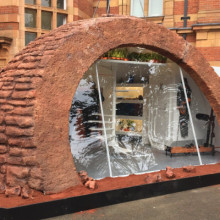
The world's first Mars show home
Marek Kooler, Royal Observatory, Greenwich
Graihagh Jackson donned her space suit to see the first Mars show home ever with Marek Kooler...
Graihagh - There’s no airlock!
Marek - Well there is now. This is the airlock.
Graihagh - But there's no cruckuchoo..
Marek - Do you want to do the sound effects?
Graihagh - I mean that was pretty good, right?
Marek - That's pretty cool, okay. So we're standing outside the Mars home and it looks like an igloo made of red martian bricks basically. But we're going to go inside now and first we have to go through an airlock, which will probably be cannibalized from one of the spacecraft. So we’re using everything once we get to the surface of Mars… so welcome to the Mars home.
Graihagh - Thank goodness. It's absolutely freezing on Mars.
Marek - Here we are in the Mars home. We’ve got everything an astronaut could possibly need. It’s quite a compact environment but also designed to feel as spacious as possible. It's quite a compact environment but also designed to feel as spacious as possible. We've got a little kitchen area down here with a microwave...
Graihagh - I see a pie!
Marek - There is a pie that would probably be freeze dried for the journey. But also there’s a little bit of salad which, hopefully, is grown here on Mars in martian soil. There's also a coffee maker and I think, hopefully again, that would be quite hipster to maybe grow your coffee in martian soil. So it would be absolutely hipster authentic coffee.
Graihagh - I’m a foodie, so if we’re going to live on Mars, good grub is paramount.
Taking food to Mars, carrying anything over that distance is very expensive so the rations will be very carefully controlled. And the logistics beforehand will be worked out so that everybody gets exactly the right amounts of carbohydrates, proteins, etc., all the vitamins they need. Of course, the idea is that we’ll be able to grow crops on Mars in covered greenhouses. We know already that we can grow Earth plants in simulated martian soil with fertilizer added and get things like potatoes and tomatoes that are actually edible. So hopefully they’ll be growing things there as well to add variety to their diet but they will be having a very controlled diet. So they’re not going to get fat and they’re not going to be eating junk food.
Graihagh - Gosh. I was just thinking, as soon as you said fat I just had an avocado for lunch and I’m thinking… no avocados on Mars.
Marek - Who knows, maybe avocados will grow really well in martian soil, in which case, that could be your end of the week treat - half an avocado.
Graihagh - The other thing that’s paramount? Sleep.
Marek - they’ve got a rest area, so this is where astronauts can relax and to also personalise their area. You’re going to have to take everything you need with you. But to keep costs and transport down, probably what they're going to have is a lot of 3D printing. So, over here in the corner we have a 3D printer just by the desk and that will be able to print out all sorts of different tools and even personal items that the astronauts might want to personalise their space. So, instead of taking everything with them, a new tool can be downloaded from Earth. It will take a few minutes for the radio signal to transmit the data but then they can just print out here on Mars So very, very useful technology that, I think, will make things a lot easier for the astronauts.
But, also, they're going to be working hard out on the surface and if you come over here you can see we have a selection of....
Graihagh - Oh rocks!
Marek - ... geologists tools and rocks so geology is going to be a big thing. We're going to want to understand the geological history of Mars, and also to look for things like fossils of past life and even evidence of current life.
So we’ve got here some rocks. These actually are real samples belonging to Professor Sanjeev Gupta from the Imperial College who is a geologist.
Graihagh - They’re not from Mars.
Marek - Well, he’s a geologist and he works on NASA’s Curiosity Mars rover mission. So these rocks are specially chosen to be the most similar rocks we can find on Earth to Mars rocks so they’re about as good as you can get.
Graihagh - Okay. And the final thing I want to talk about is the spacesuit. Because we think about space suits as these clumpy great big michelin man style things and what you've got over there is nothing like that.
Marek - Space suits on Mars I think will be a lot more slimline, and probably a little bit sexier than the ones that we’re used to seeing from the International Space Station or the Apollo missions. Those spacesuits are completely pressurised and it is like being inside a balloon if you like. The ones on Mars are going to use mechanical support to keep you held in against the lack of external pressure. So they're going to be a lot more like wetsuits perhaps with external support structures, maybe even a little bit of mechanical additions to help you to move around. They’re going to be quite constrictive, they’re going to really hold you in - a little bit like wearing a corset.
And then, of course, you'll have a helmet which will need to be pressurised and I think there are still issues to be worked through about how you marry the pressurised helmet bit with the more skintight wetsuit part of the suit. But certainly they’re going to look a lot different and, hopefully, be a lot easier to move around in. It will still be an effort though - you’re going to be working against the pressurisation and constriction of the suit. So it will be quite good exercise when you’re out there too and possibly quite tiring.
So everything you could possibly need is here. Downstairs, under the room we’re in now, would be a sleeping area possibly for about for people. And then, also, tunnels underground to connect you to other parts of the base and other Mars homes.
And also, of course, we've got a little bit of greenery in here. So this is great because it's a way of growing food. It also provides a little bit of oxygen and also I think it just give you a sense of being back home.
Graihagh - Home!
Marek - Absolutely. The psychology of the astronauts will be hugely important. So it's not just about their physical health, it is about their mental health. They're going to be working in very close quarters for several years. They all need to get on and I think they’re all going to need a little bit of personal space to go and chill out and relax. So one of the other things we have in here is virtual reality headsets so they’re going to be able to take some time out to go on a virtual reality trip home. Interact with friends and family. Just feel that they're not completely cut off from life here on Earth.
Graihagh - Now it's all very sleek and slimline and it's very compactly designed. But do you think this is realistic? An interpretation of what living on Mars might be like?
Marek - Who knows over the next couple of decades how people will decide to design the interior of these places but I think this is a pretty good guess. It's a bit like sort of Martian Ikea if you like. It's all very sleek,very kind of Scandi, quite stylish.
Graihagh - Orange and white...
Marek - Orange and white. Quite bright kind of cheery colours. I would certainly be quite happy to have this as my office and I think, actually, it's nicer than a lot of London flats. So I think they're going to be pretty happy here, you've got all mod cons. And you're also going to be part of one of the greatest adventures that humanity has ever undertaken.
Graihagh - Your name will go down in history books.
Marek - Absolutely!
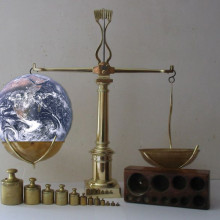
25:31 - Making Mars feel like home
Making Mars feel like home
Stephen Patranek, author of How We'll Live On Mars
Terraforming is a controversial concept but it could make Mars more like Earth, as Stephen Patranek explained to Graihagh Jackson...
Patrick - Terraforming Mars just means making Mars more like Earth. To make it more like Earth there’s a very simple problem on Mars. The atmosphere is not thick enough and it’s not breathable.
So if you were to make essentially a solar sail that was shiny on one side, it would work as a mirror. You can put it into what is called a ‘statite orbit’ around Mars and that means basically the Sun is trying to pull it away from Mars, but Mars’ gravity is trying to pull it towards Mars so it stays in one place. Then you point it at the south pole of Mars where there’s a lot of frozen carbon dioxide.
The frozen carbon dioxide is what I would call ‘not very frozen.’ In other words, ice at 32 degrees is just barely frozen. This carbon dioxide is barely frozen. You heat it up just a little with the Sun’s rays and it creates guess what…a runaway greenhouse effect on Mars - more and more CO2. As more and more CO2 enters the atmosphere and the atmosphere becomes thicker, frozen water on Mars will begin to melt, especially around the equator about 10 degrees about north latitude, 10 degrees south latitude - that band around Mars in the middle, the water will start melting.
It might freeze at night. It might be an atmosphere with an environment a lot like Canada where the water is not frozen during the day and some of it freezes at night. But when the water starts running freely on Mars and starts melting, water vapour will go into the atmosphere which will create even more of a greenhouse effect. You will get snow and you will get rain on Mars, just like we have on Earth.
The thicker atmosphere will allow sunlight, which is penetrating it not to leave and, therefore, you’ll have a heating effect on Mars, and it’ll just get warmer, and warmer, and warmer. As it gets warmer and as you get flowing water, you’ll be able to actually grow crops outdoors. Not genetically modified plants that we’re familiar with on Earth like corn and soy beans where we seem to plant everywhere. Genetically modifying those so they can take in pure CO2 is not a big problem. So suddenly you’ll be able to grow a food supply on Mars and you begin to get a very earth-like planet.
There’s a big problem which is a breathable atmosphere. That is a really tough problem to solve and that’s a thousand year problem.
Graihagh - A question here though for me is should we be doing that? Because what you’re talking about is actually climate changing when we are ruining our own planet through exactly this system. Should we be going to another planet and changing it beyond recognition?
Patrick - I understand and I’m very sympathetic to that argument. First of all, Mars is a dark, cold place. I do not believe there’s any life on Mars. We’re basically taking a rocket in space and to say that is crazy of us to try to make it more Earth-like is a crazy statement in and of itself. But here’s the big surprise… technology doesn’t move all by itself and get better all by itself - it needs motivation. What we learn on Mars about terraforming Mars is going to allow us to come on Earth to stop using our atmosphere and our water as ‘waste disposal systems,’ because on Mars, you will not be allowed to have any waste disposal at all. You will have to recycle everything all the time. The technologies we learn on Mars are going to make Earth a much better place much faster.
Graihagh - A hugely positive aspect of this mission. But would Stephen and Marek themselves go?
Stephen - I would, I’d go tomorrow. It would be the greatest adventure of a lifetime. Elon Musk is famous for saying “I want to die on Mars but not on impact,” and I agree with that. I wouldn’t mind dying on Mars. That would be a good place to go later in life… great last adventure.
Marek - I would be really happy to go and visit Mars. I would even go for a couple of years, but only if I could come back. The Earth is, I think, the most beautiful and amazing planet that we’ve discovered so far in the whole universe. Certainly, it’s the most beautiful planet in the solar system.I have not finished exploring it and I wouldn’t want to give up on the Earth. So yes, I would go to Mars for a trip but I would definitely want to come back afterwards.
But I think what’s really exciting about this showhome is, over the next weeks, we’re going to get loads of kids coming into the observatory. Hopefully, they’re going to get excited and inspired by this, and some of them may think about careers in science and technology. Those kids are exactly the right age now to be among the first people to travel to Mars in the 2030s. But, who knows, perhaps the first martian astronaut is going to be visiting us at Greenwich over the next week, and that is a really exciting thing.
Graihagh - Blimey it is indeed, isn’t it?
Graihagh - As the only person who really knows what it’s like to be so far from our home planet, I want to leave you with some rather illuminating thoughts from our astronaut, Stanley G Love.
Stanley - I have this memory of being finished with the space walk, waiting outside the airlock to come back in inside and out shuttle's orbit took us up over the pacific ocean and across the western part of the United States. And just having that immense tableau of the scenery of all the world that I’ve known growing up and that just comes rolling up underneath me as we were finishing that space walk and feeling good about it. That was a wonderful, wonderful experience and something I’ll remember for the rest of my life.
Graihagh - It sounds beautiful.
Stanley - It is. I’d like to say, and this is a strong statement coming from somebody with a background in astronomy is that the Earth is the most interesting thing in space. So I’m hoping that, in the future, more and more people can see what it’s like to be in orbit, look down at the Earth and see what it really looks like, and observe our home as a planet rather than just as something you drive around to work and back every day. I think it will make us all better people to have that experience.










Comments
Add a comment